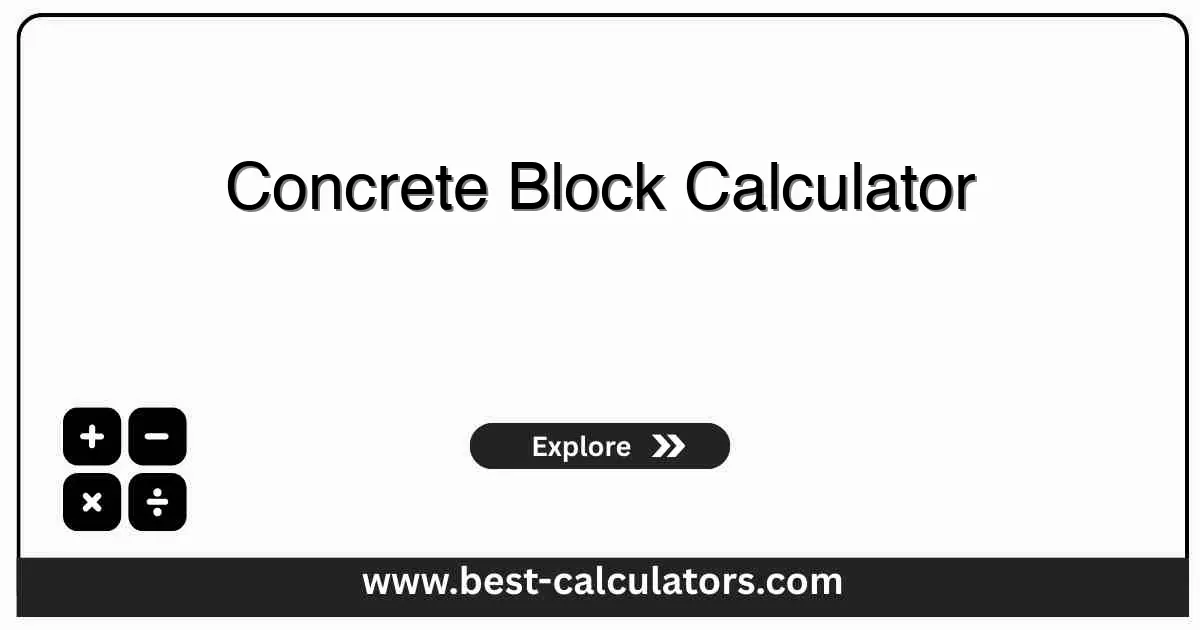Concrete Block Calculator - Calculate Blocks & Mortar for Walls
Free calculator to determine concrete blocks needed for walls, mortar requirements, and material costs for masonry construction projects
Concrete Block Calculator
Results
What is a Concrete Block Calculator?
A concrete block calculator is a free construction tool that helps you accurately estimate the materials needed for concrete masonry unit (CMU) construction projects. It calculates block quantities, mortar requirements, and total costs for walls and structures.
This calculator works for:
- Residential construction - House walls, foundations, and garages
- Commercial buildings - Office walls, retail spaces, and warehouses
- Retaining walls - Landscape walls and property boundaries
- Foundation walls - Basement and crawl space construction
- Cost estimation - Accurate budgeting for masonry projects
- Material planning - Proper ordering and waste reduction
For other masonry and construction projects, explore our Brick Calculator for brick masonry work, Chimney Calculator for chimney construction, and Concrete Calculator for poured concrete projects.
How Concrete Block Calculator Works
The calculator uses precise mathematical formulas to determine concrete block requirements:
Where:
- Wall Area = Length × Height (square feet)
- Block Area = (Block Length + Joint) × (Block Height + Joint)
- Waste Factor = Additional percentage for cuts and waste
- Mortar per Block = Volume of mortar needed per block
Key Concepts Explained
Block Sizes
Standard CMUs are 8×8×16 inches. Other sizes include 6×8×16 (half height), 4×8×16 (quarter height), and 12×8×16 (full height) blocks.
Mortar Joints
Standard mortar joints are 3/8 inch thick. Joint thickness affects both block count and mortar volume calculations.
Waste Factor
Additional blocks needed for cutting around openings, corners, and to account for breakage during construction.
Block Layout
Blocks can be laid flat (stretcher), on edge (soldier), or standing up (sailor), affecting coverage area per block.
How to Use This Concrete Block Calculator
Enter Wall Dimensions
Input wall length and height in feet for accurate area calculation.
Select Block Size
Choose from standard, half height, quarter height, or full height blocks.
Set Mortar Joint
Specify mortar joint thickness (typically 3/8 inch).
Add Waste Factor
Include waste percentage (typically 10-15%) for cuts and breakage.
Enter Costs
Optional: Add block and mortar costs for total project estimate.
Get Results
View block count, mortar requirements, and total costs.
Benefits of Using This Calculator
- • Accurate Material Estimation: Prevents over or under-ordering of concrete blocks and mortar for your project.
- • Cost Savings: Avoid expensive mistakes and ensure you purchase the right amount of materials.
- • Time Efficiency: Quick calculations save time compared to manual measurements and complex formulas.
- • Professional Planning: Helps contractors provide accurate bids and project timelines.
- • Waste Reduction: Proper waste factor calculations minimize material waste and disposal costs.
- • Project Budgeting: Clear cost breakdown helps with project budgeting and financial planning.
Factors That Affect Your Results
1. Wall Openings
Doors, windows, and other openings reduce the actual wall area that needs concrete block coverage.
2. Block Layout Pattern
Different block laying patterns (running bond, stack bond, etc.) affect block count and appearance.
3. Foundation and Corners
Foundation requirements and corner treatments may require additional blocks or special cuts.
4. Building Codes
Local building codes may specify minimum block sizes, mortar types, and structural requirements.
5. Weather Conditions
Construction in adverse weather may increase waste due to damaged or unusable materials.
6. Block Quality and Tolerance
Manufacturing variations in block dimensions may affect the number of blocks needed for precise fits.

Frequently Asked Questions (FAQ)
Q: How do I calculate the number of concrete blocks needed for a wall?
A: Multiply wall length by height to get wall area, then divide by the area of one block (accounting for mortar joints). For example, an 8x8x16 block covers about 0.89 sq ft per block in a wall.
Q: What is the standard size of a concrete block?
A: Standard concrete blocks (CMUs) are 8 inches high, 8 inches deep, and 16 inches long. However, blocks can vary from 4x8x16 to 12x8x16 inches depending on the application.
Q: How much mortar do I need for concrete blocks?
A: For standard 3/8 inch mortar joints, you'll need about 0.05-0.08 cubic feet of mortar per block. Always add 10-15% extra for waste and uneven joints.
Q: What factors affect concrete block calculations?
A: Key factors include block size, mortar joint thickness, wall openings (doors/windows), waste factor, block layout pattern, and whether blocks are laid flat or on edge.